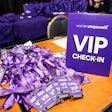In today's connected world, improving cyber safety is crucial, not only for managing attendees’ expectations, but because every phone, tablet and laptop is an entry point for potential harm to planners, delegates and their events.
In 2018, the Events Industry Council’s Industry Insights Committee conducted a survey of more than 200 event professionals on cybersecurity readiness. The survey found that while 82.46 percent of respondents feel that a data breach has the potential to adversely affect their organization, only 26.56 percent are aware of having an information security policy that provides for events. Survey respondents who had a meeting or event adversely affected by a data breach report the effects have included time away from managing the event, brand reputation damage, legal fees, financial damage, fines and attendee dissatisfaction. 1
Protecting Event-Related Data: Focus on Company Confidential Information
Broadly speaking, criminals will be interested in four types of information that event professionals may have: personal information, payment card information, company confidential information and other client data.Protecting Company Confidential Information at Paperless Events
More and more events are going paperless, and it’s easy to understand why: Paperless meetings allow you to reduce printing (and environmental) costs, they are more forgiving for last-minute edits and participants appreciate the convenience of having the information they need on their devices. With that said, paperless events can increase your cyber risks. Fortunately, there are practical ways to mitigate that risk. Events can be an easy gateway for corporate espionage: Confidential information may be available on unsecured networks, and data such as financial information, business projections and operations manuals may be shared with participants. Paper-based meetings have the advantage of being able to track and manage who had access to reports, and these could be collected and shredded at the end of the event. Here are a few simple steps to make it more difficult for hackers to access your company confidential information at your events:- Don’t display detailed confidential information if you don’t need to.
- Use a secure board app for sharing documents.
- Delete files from event laptops.
- Have a social media policy and share this with your participants.
- Arrange for a secure, password-protected network.
General Guidance
While no system is perfect, you can make it harder for your data to be breached. Some specific actions that you can take to protect your own data and systems include:- Be suspicious of emails, pop-ups and websites. Use the old-fashioned way—go to the legitimate website and log in. If there’s an inkling of a doubt, don’t click!
- When available, use two-factor authentication.
- Use a virtual private network (VPN).
- Avoid using USB flash drives to transfer files.
- Backup, backup, backup!
- Use a password manager.
- Don’t store information you don’t need.















